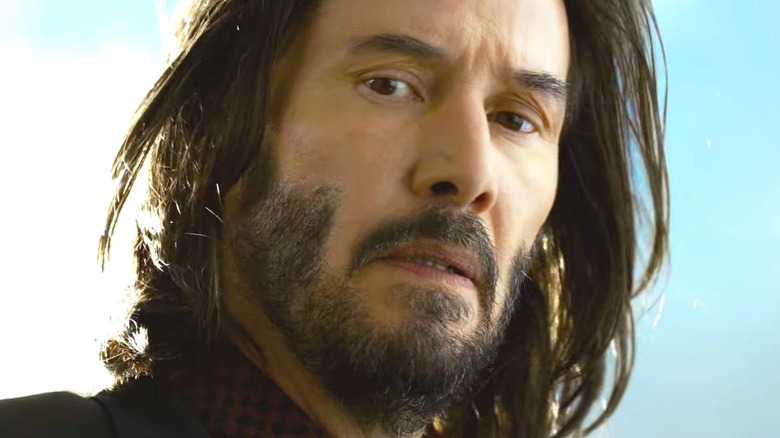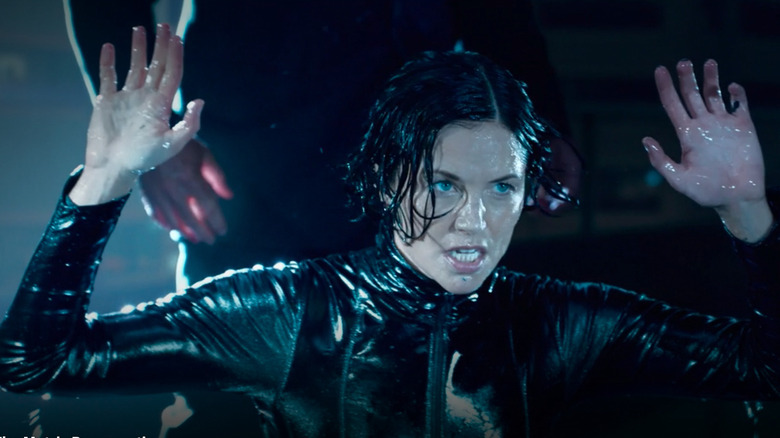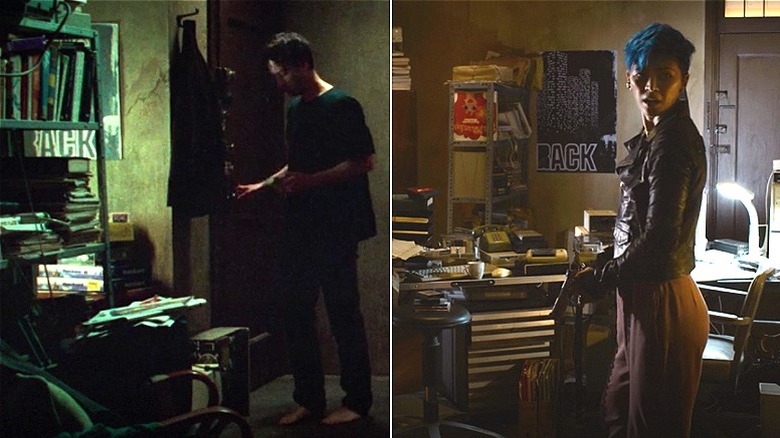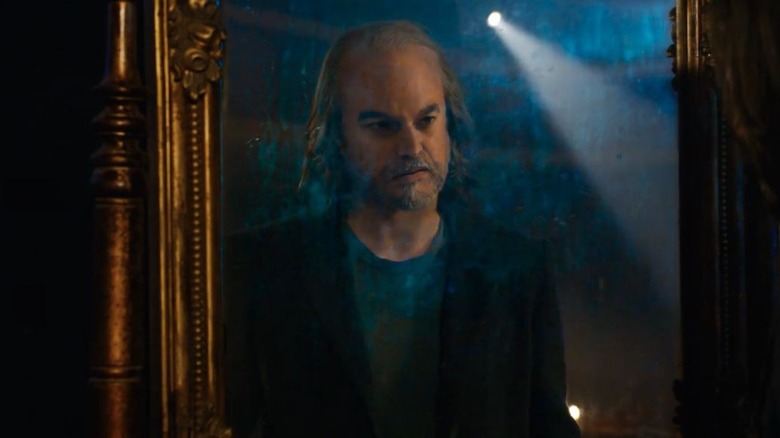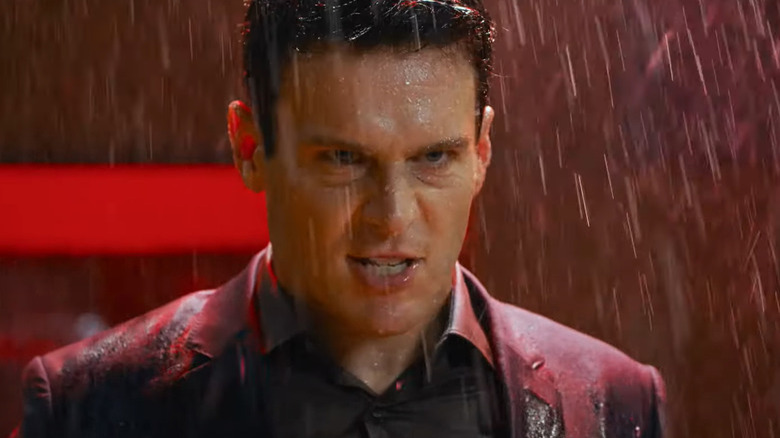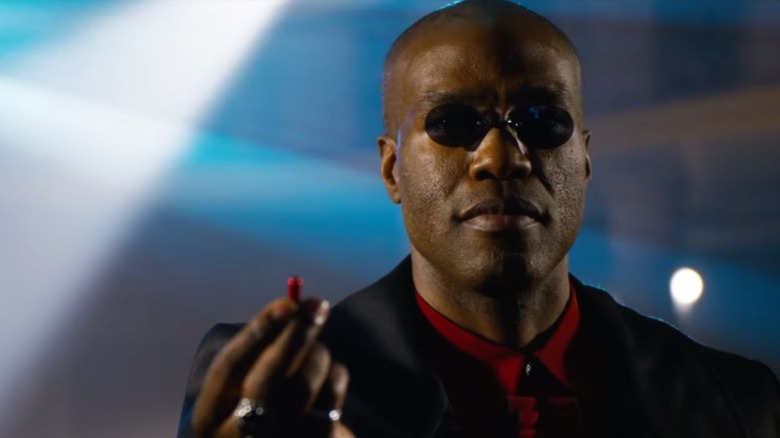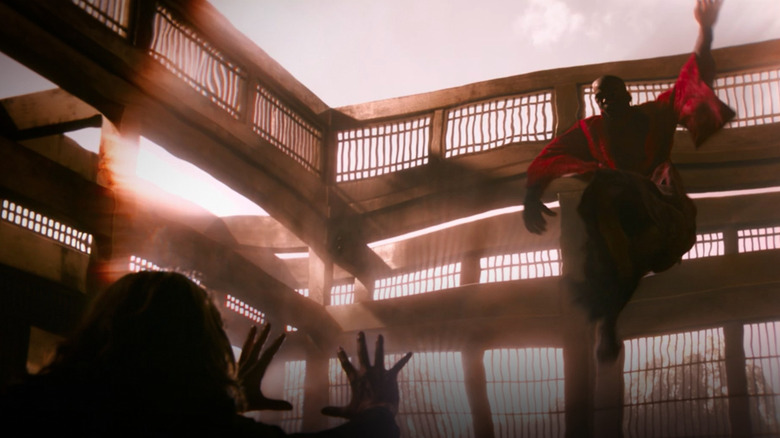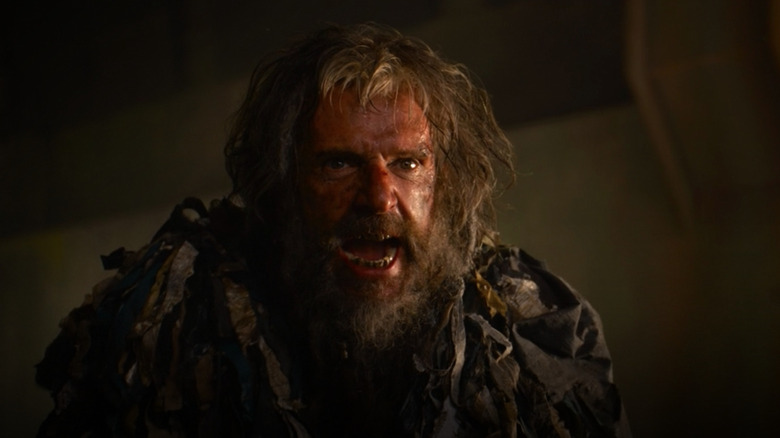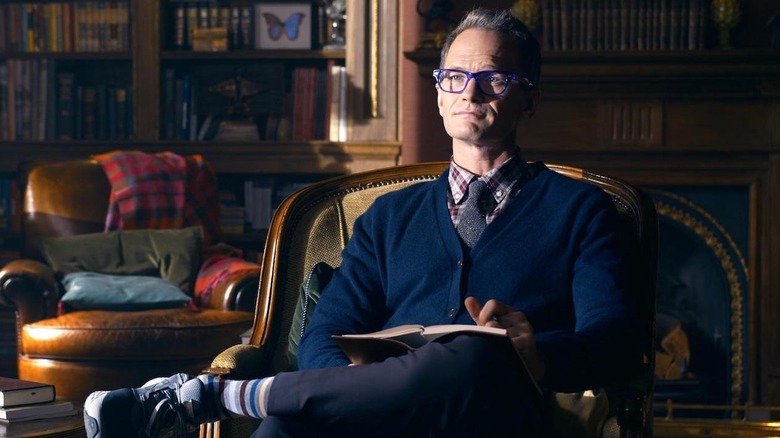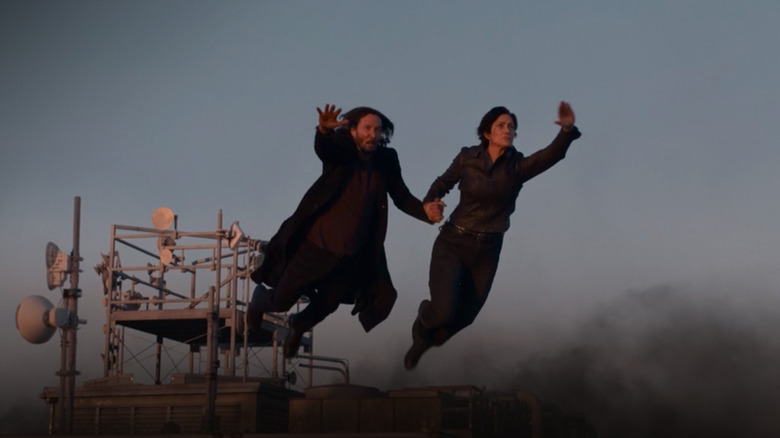The Most Paused Moments In The Matrix Resurrections
This article contains spoilers for "The Matrix Resurrections."
Audiences are pretty divided over "The Matrix Resurrections." Depending on who you talk to, it is either a subversive blockbuster masterpiece or a third disappointing sequel. Regardless, the fourth installment of the classic sci-fi series has people talking.
Set 60 years after the events of "The Matrix Revolutions," the movie opens inside a program inside the new Matrix before revealing that Neo (Keanu Reeves) is once again trapped inside the Matrix as Thomas Anderson. In this extremely meta layer of simulation, Anderson is a game designer. He is the creator of a trilogy of video games called "The Matrix," based on the events of the trilogy that Neo has remembered but the machines have made him internalize as fiction. After discovering the legend still lives, a group of hackers make it their mission to free Neo and Trinity (Carrie Ann Moss) from the Matrix in a story that parallels the first movie.
"Resurrections" is a dense, meta-textual meditation on choice, filled with callbacks and easter eggs that make you want to pause, take a breath, rewind — and re-watch the entire "Matrix" series all over again, really. And now, thanks to the advent of streaming and simultaneous at-home and theater releases, fans of "The Matrix Resurrections" can create many of their own deja vu moments with the power of the pause button alone. We've gathered a list of the best ones. Major spoilers ahead.
Uh... That's not Trinity
Setting the stage for an unbelievably meta first act, the opening of "The Matrix Resurrections" mirrors the opening of 1999's "The Matrix" — but not everything is quite as it seems. For starters, Morpheus is decidedly different this time, played by the stylish Yahya Abdul-Mateen II. Two new characters, hackers Bugs (Jessica Henwick) and Seq (Toby Onwumere), are also on the scene, and they, like the audience, know this scene, and know that something is off.
As we move to the introduction of Trinity, we see Bugs observing, but pause the moment and you'll realize early that this is not Carrie Ann Moss and this is very much not the opening of "The Matrix." Bugs realizes it out, too, but pause on an earlier frame and you'll be one step ahead of the game. This reveal leads to the scene branching and eventually revealing the entire intro takes place inside a modal inside the Matrix.
Inside the world of "The Matrix," a modal is a testing sandbox that exists isolated from a program while still using the code of that program. For example, the modal Neo creates in the film exists within the game he has created based on the original trilogy. Another bonus pause comes when Bugs must flee this voyeuristic revelation, and she crashes into a neon marquee marked "Anderson's," a dead giveaway that we are in a modal created by Neo himself, a fact that isn't revealed until a little bit later.
Going back to where it all began
After being discovered by agents while peeping on the faux Trinity intro, Bugs finds herself being chased by the program that will soon be revealed to her to be Morpheus. In a room full of keys (yes, this is 100% a reference to the Keymaker from "Reloaded"), she finds a door to another room in the modal where she ends up confronting the program. As it turns out, he has been here before. This is where it all began. We are in Thomas Anderson's room from the start of "The Matrix."
The room is a replica of Neo's cramped hacker apartment and everything in it. If you pause the movie for certain frames during this scene you can look around and experience a plethora of nostalgia. Full of knick knacks and callbacks, this sequence shows on full display just how dense with meaning the sets in "Resurrections" are. You can see a replica of Neo's old computer, still intact. At a certain point Bugs picks up the old MetaCortex ID marked Thomas Anderson. Every detail down to the same poster on the wall and open bottles and cans of Coke littered around the microwave is intact.
This scene holds another crucial moment. In it, Bugs confirms the program to be a Morpheus subconsciously created by Neo within the Matrix, thus understanding the "One" is still alive and closer than anyone realized.
Bugs sees a glimpse of Neo's true form in the Matrix
In a scene where Bugs is explaining her motivations for pursuing Neo and freeing him, we are shown a very pause-worthy flashback. As Bugs explains it, we see her washing a skyscraper window. Then, from atop the building, Neo is seen jumping off, but for a split second we see an image of an old man in his place. As he turns to Bugs, he is once again the bearded Keanu Reeves that we know and love as Neo in "The Matrix Resurrections." This moment gave Bugs hope and proved Neo was still out there somewhere. This sets her character arc into motion, paralleling the arc of Morpheus in the original "Matrix."
This moment is the first clue the film gives about a late-game twist that is yet to come. Later, we come to understand this moment as Bugs seeing Neo in his true form, not the old man that the rest of the residents of the Matrix see him as. Throughout the movie, up until the reveal, there are shots of the man everyone sees him in reflections that hint at the truth. Late in the film, it is revealed by the Analyst (Neil Patrick Harris) that this sighting was actually a previous escape attempt by Neo.
The real agent Smith is revealed
If you managed to avoid all marketing material for "Resurrections" beyond the initial trailer, you probably found yourself shocked by the reveal of Jonathan Groff's character to be Agent Smith. Especially after the movie intentionally misled the audience by not casting Hugo Weaving in the role he immortalized. Even if you knew Groff's true role going in, the moment where he finally goes mask off and shouts "Mr. Anderson" in his best Hugo Weaving voice is one of the most spine-chilling moments of the film. The shoot-out that ensues is stylish, fast, and features a whole lot of Yahya Abdul-Mateen II looking sweet in a suit and some sick gun kata.
Later on, the reason for Smith's role in Neo's simulated life is explained. Rewatching the movie, a must for "Matrix" fans with an HBO Max subscription, it is easy to see that Smith was placed as Thomas Anderson's business partner to keep Neo in check. This allowed the Analyst to be able to observe Neo at all times.
Neo takes the red pill again
One pill makes you larger and one pill makes you small. Sure, you've probably heard Jefferson Airplane's "White Rabbit" countless times in the marketing run-up to the release of "Resurrections," but it really is a perfect song to score the return to "The Matrix." The pivotal scene where Neo finally takes the red pill again is dense with callbacks to the first movie.
The setting is incredible. Neo enters a room that closely resembles the abandoned building where he took the red pill in the first movie. And on the projection screen behind him that is lining the wall, the original scene from the 1999 "Matrix" is playing on a loop. It is a huge meta moment for the movie, one that brings into question the themes of choice and repetition. When Morpheus says in this scene, "Nothing comforts anxiety like a little nostalgia," he is both referring to creating a more comfortable environment to coerce Neo into take the pill, and making a meta commentary. Neo has been here before. In the words of the Oracle, he has already made the choice.
Through this scene and many more, filmmaker Lana Wachowski analyzes the pervasiveness of franchises and reboots, by resurrecting past scenes, characters, and motifs to interrogate how her work was interpreted versus her own philosophies. Perhaps the biggest conflict of that dynamic, pre-"Resurrections," is the way the alt-right fringe co-opted the phrase red-pilled, much to Wachowski's frustration.
Neo and Morpheus return to the training Dojo
At this point in "The Matrix Resurrections," you're probably expecting the scene that is about to come. That doesn't make it any less awesome, though. After returning to real life, Neo is immediately jacked back in, and, like in the 1999 original, is transported to a pure white room — "the construct" — where Morpheus awaits his arrival. This is where Morpheus explains what exactly he is, an algorithm written by Neo that is in fact constructed from the memories of both Morpheus and Agent Smith. From here, of course, we must move to the dojo.
The training dojo where the epic Neo and Morpheus fight occurs in "The Matrix" makes a return in "Resurrections." The fight that ensues between Neo and this new version of Morpheus mirrors the original, but the stakes are raised. In this scene, if Neo can't find the power in himself to win he will die. Morpheus almost defeats Neo. While the ex master of Kung Fu lies on the ground, Morpheus reminds him of the one thing he is fighting for; Trinity. This results in Neo finally regaining his Matrix superpowers (well, some of them) and turning the whole dojo into a bright supernova, thus passing the test and waking him up.
The Merovingian makes a brief but memorable return
While a great deal (pretty much the entire first half, actually) of "The Matrix Resurrections" acts as an homage and deconstruction of the original "Matrix" movie, it is also a direct sequel to "The Matrix Revolutions." Lana Wachowski decided to bring back some of the primary characters from the sequels, including Morpheus' old flame and butt-kicking captain Niobe (Jada Pinkett Smith) and everyone's favorite scene-chewing program, the Merovingian.
Speaking of Merv (Lambert Wilson), as the fanbase grew to call him after Trinity so glibly nicknamed him in "The Matrix Revolutions," the Frenchman himself makes a return in "Resurrections." The exiled program is in a haggard state, though. His beard and grimy appearance are a polar opposite from the way we see him present in the first two sequels. Blaming Neo for his decrepit state, he goes on a fourth-wall breaking rant about the digital age, including a great moment of lamenting how "style" and "great conversation" has been replaced by the "beep beep beep beep beep" of incessant texting. We cannot repeat what he calls Wikipedia, but the very direct reference to social media as "Face-zucker-suck" is the highlight of the rant. Granted, you can't hear it when paused, but that line alone is worth rewinding to hear again.
The Analyst's explanatory monologue may require a rewind
Late in "The Matrix Resurrections," Neil Patrick Harris' character, "The Analyst," who acts as Thomas Anderson's therapist in the new simulation, is revealed to be the big bad. The Analyst created this new Matrix and is, more or less, the "Resurrections" version of the Architect from "Matrix Reloaded" and "Revolutions." Using his ability to slow down time in the Matrix, the Analyst shoots a bullet towards Trinity. As Neo runs to stop it in slow-motion, NPH is given plenty of time to prattle on about Neo, Trinity, and free will.
This is a dense monologue, full of both key plot point explanations and exploration of the movie's themes of love, choice, and binaries. In it, the Analyst explains why Neo and Trinity were resurrected and how their role in the new Matrix benefits the machines. After the events of "Revolutions," both were presumed dead, but their bodies were recovered and placed into a new iteration of the Matrix by the Analyst. By keeping Neo and Trinity near each other, but not close enough to ever find each other (or resetting the simulation whenever they did), the machines can harvest near limitless power from the two. The yearning that each feels for the other in their dormant minds is enough to power entire machine cities. The scene is definitely worth rewinding and watching again if you are catching the movie on HBO Max, because there is a lot to take in here.
Woah, Trinity is flying
Probably the single best "holy sh**" moment of "The Matrix Resurrections" comes at the very end — and it is well worth the wait. For some fans, this wait has been over 18 years. In the climactic moment of the film, Neo and Trinity clench hands and jump off of a rooftop. This leap of faith is a fake-out. The whole movie, fans have been waiting for Neo to regain his ability to fly, and this feels like the moment it is about to happen. And then it doesn't. Not quite.
After their leap, Neo begins to fall. And then he is caught. The camera pans up to show that this time it is Trinity who has the power of flight. It is an awe-inspiring shot that single-handedly gives Trinity fans the best moment they didn't even know they wanted. The entire movie is a tribute to Carrie Ann Moss and Trinity as much as it is one to Neo and Keanu Reeves. For the two of them, the end of "Resurrections" is only a new beginning. For the rest of us, well, we will just have to wait and see.
